Edward Pritchett stands as a notable figure among the British artists who fell under the spell of Venice in the 19th century. Though details of his life remain frustratingly scarce, his paintings offer a vibrant testament to his skill and his deep affection for the floating city. Active during the Victorian era, Pritchett specialized in depicting the architecture, canals, and daily life of Venice, creating works celebrated for their atmospheric quality, lively execution, and a handling of light that bordered on the Impressionistic. His canvases capture the unique energy and visual splendor of Venice, securing his place within the long tradition of Venetian view painting, known as vedute.
While the dates 1808-1894 are often cited for Edward Pritchett, historical records present some ambiguity. Some sources suggest a possible birth year of 1828, aligning more closely with documented exhibition records spanning from roughly 1828 to 1864. This uncertainty highlights the challenges in reconstructing the biographies of artists who, despite achieving contemporary recognition, did not leave behind extensive personal archives. Regardless of the precise dates, his artistic output firmly places him as a significant Victorian painter of Venetian scenes.
Biographical Uncertainties and Known Details
The quest to piece together the life of Edward Pritchett is hampered by a lack of comprehensive documentation. The commonly accepted lifespan, 1808 to 1894, finds some support, including records pointing to a birthplace in Crowborough, Sussex, England. However, the alternative suggestion of an 1828 birth year persists, creating a degree of biographical haze. This confusion is compounded by the existence of another British artist, Robert Taylor Pritchett (1828-1907), who also painted marine subjects and Venetian scenes, leading to potential misattributions or conflation over the years. It is important, therefore, to distinguish Edward Pritchett, the subject of this discussion, from his namesake.
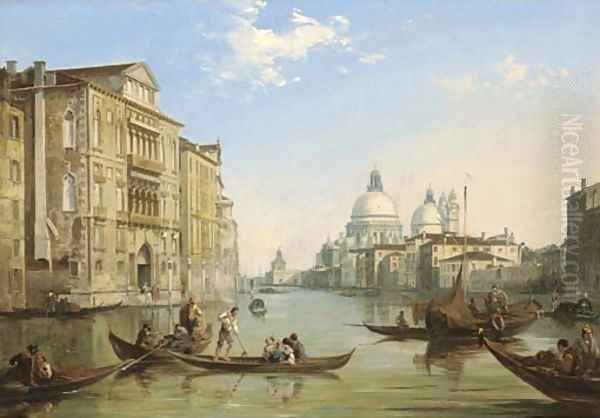
What is clearer is Pritchett's professional activity. He was an active exhibitor in London, showcasing his works at prestigious venues. Records indicate numerous appearances at the Royal Academy of Arts, a cornerstone institution of the British art establishment. He also exhibited frequently at the British Institution, another important venue for artists during the period. These exhibitions provided crucial platforms for visibility and sales, suggesting that Pritchett achieved a respectable level of success and recognition during his working life.
Despite this public presence through exhibitions, Pritchett remains an enigmatic figure personally. We lack the diaries, extensive letters, or detailed contemporary accounts that illuminate the lives of some of his more famous peers. His biography must largely be inferred from his artistic output and the sparse official records available. His legacy, therefore, rests primarily on the visual evidence of his canvases – paintings that speak eloquently of his talent and his chosen subject matter, even if the man himself remains partially obscured by time.
The Allure of Venice: Pritchett's Chosen Subject
Venice has long exerted a powerful magnetic pull on artists. From the Renaissance onwards, but particularly from the 18th century with the rise of the Grand Tour, the city became an essential destination. Its unique topography – a city built on water, devoid of conventional streets and reliant on canals and boats – offered unparalleled visual motifs. The interplay of light on water, the reflections of ornate architecture, the dramatic skies, and the sheer theatricality of its existence provided endless inspiration.
Painters like the 18th-century masters Antonio Canaletto and Francesco Guardi established the veduta tradition, creating detailed and atmospheric views that were highly sought after by wealthy travelers, especially the British. Canaletto, known for his almost photographic precision and clarity, documented the city's landmarks with meticulous care. Guardi, often considered Canaletto's successor though developing his own distinct style, favored a looser, more atmospheric approach, capturing the ephemeral qualities of light and movement with flickering brushstrokes, known as pittura di tocco.
By the 19th century, when Pritchett was active, Venice retained its allure, but the artistic approach began to shift. While the demand for recognizable views persisted, artists became increasingly interested in capturing subjective impressions, mood, and the transient effects of light and weather. The rise of Romanticism, and later Impressionism, influenced how artists perceived and depicted the city. Figures like the great British painter J.M.W. Turner had already explored Venice's atmospheric potential in breathtaking, almost abstract canvases decades earlier. Pritchett operated within this evolving context, inheriting the veduta tradition but infusing it with a distinctly Victorian sensibility and a style responsive to contemporary artistic currents.
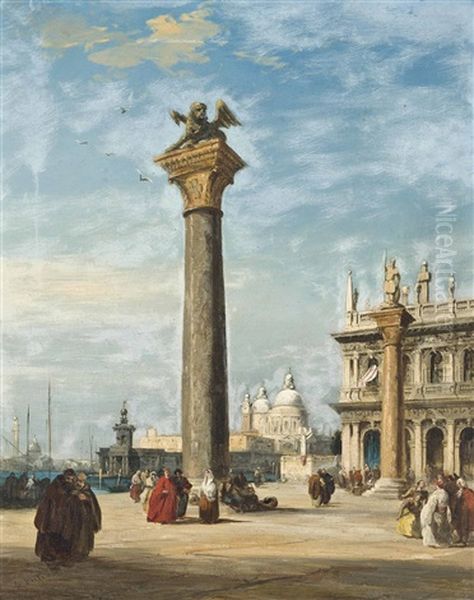
Pritchett focused his attention on the iconic sights that defined Venice for his audience. The Grand Canal, the city's main artery, features prominently, often depicted bustling with gondolas, barges, and sailing vessels. St. Mark's Square (Piazza San Marco), famously dubbed "the drawing room of Europe," appears frequently, capturing the grandeur of the Basilica di San Marco, the Campanile, and the Doge's Palace. Other key landmarks like the church of Santa Maria della Salute, guarding the entrance to the Grand Canal, and the Dogana da Mar (Customs House) were also favourite subjects, rendered with an appreciation for both their architectural form and their picturesque placement within the cityscape.
Artistic Style: Light, Atmosphere, and Impressionistic Tendencies
Edward Pritchett's style is perhaps best characterized by its liveliness and its sensitivity to light and atmosphere. While clearly knowledgeable about architectural detail and capable of rendering it accurately, his primary interest often seems to lie in capturing the overall mood and visual vibrancy of the scene. His brushwork, particularly when compared to the tighter handling of earlier vedutisti like Canaletto, can be relatively free and fluid, contributing to the sense of immediacy and freshness in his work.
His paintings are often described as "almost Impressionistic," and this comparison holds merit. Pritchett demonstrated a keen interest in the effects of light – the sparkle of sunlight on the lagoon, the soft haze of a Venetian morning, the warm glow of late afternoon illuminating building facades. He achieved this through skillful colour modulation, often employing a warm palette, and through broken brushwork that suggests rather than meticulously delineates every detail, particularly in reflections and skies. This approach allows the viewer's eye to blend the colours, creating a shimmering effect that evokes the unique optical experience of Venice.
This focus on transient effects aligns him with the broader concerns of Impressionist painters like Claude Monet and Pierre-Auguste Renoir, who themselves would later paint in Venice, captivated by its light. While Pritchett may not have pushed towards the dissolution of form seen in mature Impressionism, his emphasis on capturing a specific moment's light and atmosphere, his relatively loose handling, and his vibrant depiction of everyday life certainly show a related sensibility. He successfully balanced the topographical demands of view painting with a more modern, subjective interest in visual sensation.
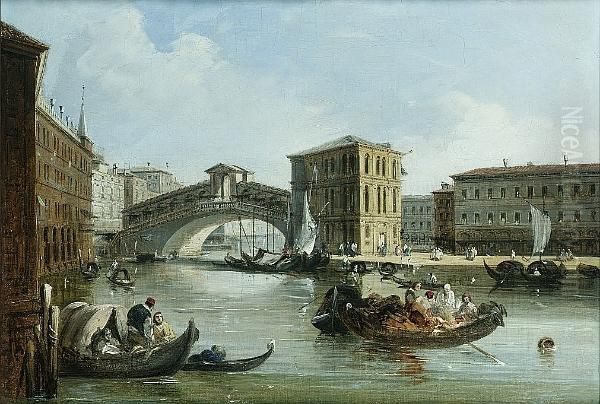
His compositions often emphasize the dynamic interplay between architecture, water, and human activity. Figures are not mere staffage but integral parts of the scene, animating the squares and canals. Gondolas glide across the water, their reflections adding movement, while crowds gather in the Piazza, suggesting the city's social life. This integration of elements contributes to the overall vitality of his work, presenting Venice not as a static museum piece but as a living, breathing entity. The resulting paintings possess a charm and energy that appealed greatly to his Victorian audience.
Key Works and Common Themes
Among Edward Pritchett's most recognized and representative works are his numerous views of the Grand Canal and St. Mark's Square. The Grand Canal, Venice is a title applied to several works capturing different vistas along the city's main waterway. A particularly favoured viewpoint, often depicted by Pritchett, is the entrance to the canal, looking past the Dogana da Mar towards the magnificent baroque dome of Santa Maria della Salute. These paintings typically showcase the bustling water traffic – gondolas, sailboats, perhaps a steam vessel – under expansive skies, with the famous landmarks providing a majestic backdrop bathed in characteristic Venetian light.
Another signature work, sometimes titled Venice, in front of Santa Maria della Salute, focuses more closely on this iconic church. Pritchett captures its impressive architecture and its prominent position on the Dorsoduro peninsula, often including the steps leading down to the water and the varied boat life nearby. His skill in rendering the texture of stone, the play of light and shadow on the ornate facade, and the reflections in the foreground water is evident in these compositions.
Views of the Piazza San Marco were also central to his oeuvre. Paintings like Piazza San Marco, Venice depict the vast square, often teeming with figures – locals, tourists, vendors – conveying the vibrant social life that unfolded against the backdrop of the Basilica, the Campanile, and the Doge's Palace. Pritchett excelled at suggesting the scale and grandeur of the space while simultaneously capturing the intimate details of human interaction and the specific quality of light filling the square at different times of day.
Beyond these major landmarks, Pritchett likely painted numerous other Venetian scenes – quieter side canals, picturesque bridges like the Rialto, views towards the lagoon islands, and perhaps festival scenes like the Regata Storica, although specific titles for these are less consistently documented. Across all these themes, his work is unified by its atmospheric quality, its lively depiction of the city's unique character, and its appealing blend of topographical accuracy and painterly freedom. His paintings offered Victorian audiences captivating glimpses into the enduring magic of Venice.
Pritchett in Context: Predecessors and Contemporaries
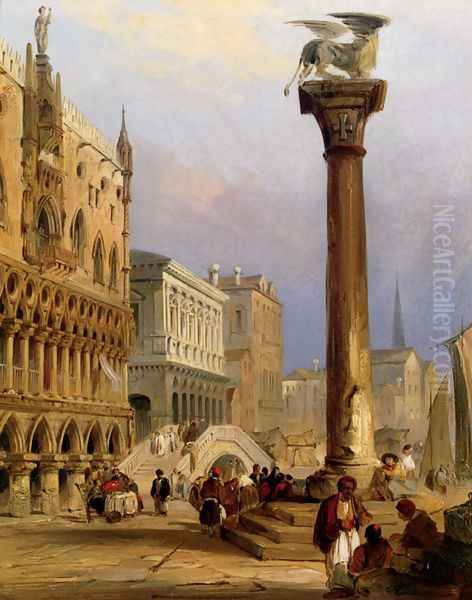
Edward Pritchett's work did not arise in a vacuum. He was part of a long and rich tradition of artists depicting Venice, and his style reflects both his inheritance from predecessors and his engagement with contemporary artistic trends. The influence of Canaletto and Guardi is undeniable; they established the foundational iconography and compositional types for Venetian vedute that Pritchett clearly knew and utilized. Canaletto's precision provided a benchmark for architectural accuracy, while Guardi's atmospheric freedom offered a precedent for Pritchett's looser handling and focus on light.
Within the British context, the towering figure of J.M.W. Turner looms large. Turner's revolutionary interpretations of Venice, painted earlier in the 19th century, pushed the boundaries of representation, dissolving form in dazzling displays of light and colour. While Pritchett's work remained more representational, Turner's exploration of Venice's atmospheric potential undoubtedly contributed to the artistic climate in which Pritchett worked and likely encouraged a greater focus on light and mood among subsequent generations.
During Pritchett's active years, other artists were also drawn to Venice. The American expatriate James Abbott McNeill Whistler, active primarily in London and Paris, created highly influential, atmospheric etchings and paintings of Venice (his "Nocturnes" and pastels) in the late 1870s and early 1880s, overlapping with Pritchett's later period. Whistler's tonal harmonies and suggestive approach offered a different, more aesthetically refined vision of the city.
Later in the century, artists like John Singer Sargent would become famous for their Venetian scenes, particularly Sargent's brilliant, fluid watercolors capturing light on architecture and water. British artists like Walter Sickert, though often depicting a grittier, less romanticized Venice, also contributed to the ongoing artistic engagement with the city. Furthermore, the French Impressionists, including Claude Monet and Pierre-Auguste Renoir, visited and painted Venice, bringing their own techniques for capturing fleeting light effects to the familiar subject matter. Pritchett's style, with its proto-Impressionist leanings, resonates with these broader European developments.
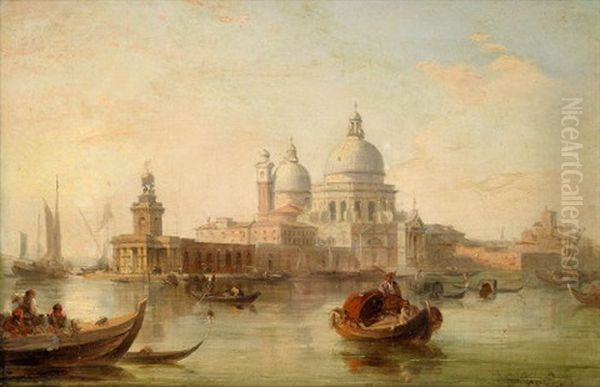
Among Italian painters closer to Pritchett's time, Ippolito Caffi (1809-1866) was a notable contemporary known for his often dramatic and nocturnal views of Venice, sometimes incorporating unusual perspectives or events like balloon ascents. Later Italian artists like Guglielmo Ciardi continued the tradition of Venetian landscape painting into the later 19th and early 20th centuries. While direct influence is hard to trace without more biographical data, Pritchett worked within this international milieu of artists fascinated by Venice, each contributing their own interpretation. We should also remember Robert Taylor Pritchett, the other British artist of the same name, whose career painting marine and Venetian subjects paralleled Edward's, adding another layer to the context of the time. Mentioning the great Italian etcher Giovanni Battista Piranesi (1720-1778) is also relevant, not as a painterly contemporary, but as an artist whose dramatic architectural prints, particularly of Rome but influencing architectural representation generally, formed part of the visual culture preceding Pritchett.
Legacy and Reception
During his lifetime, Edward Pritchett achieved considerable recognition, primarily through his regular exhibitions in London. His Venetian views found favour with the Victorian public and collectors, who appreciated their picturesque qualities, their evocative atmosphere, and their connection to the popular Grand Tour destination. The consistent demand for his work, evidenced by his exhibition record and the number of paintings that survive today in private and public collections, speaks to his contemporary success. His works entered numerous British collections, offering homeowners a tangible, romantic reminder of the famous Italian city.
However, despite this contemporary popularity, Pritchett's historical profile has become somewhat obscured. The lack of detailed biographical information has made it difficult for art historians to construct a full narrative of his life and career, unlike some of his better-documented peers. Furthermore, the sheer number of artists painting Venice, including giants like Canaletto and Turner, means that accomplished but less revolutionary figures like Pritchett can sometimes be overshadowed in broader art historical surveys. The confusion with Robert Taylor Pritchett may also have diffused his individual identity in the historical record.
Nevertheless, Edward Pritchett's paintings continue to be appreciated by collectors and enthusiasts of 19th-century British art and Venetian vedute. His works regularly appear at auction, often commanding respectable prices, indicating a sustained interest in his particular vision of Venice. Art historians recognize his skill in capturing the city's unique light and atmosphere, and his position as a significant practitioner of Venetian view painting in the Victorian era.
His contribution lies in his ability to synthesize the traditional demands of the veduta with a more modern, almost Impressionistic sensibility towards light and brushwork. He captured the enduring magic and beauty of Venice with a freshness and vitality that clearly resonated with his contemporaries and continues to charm viewers today. His paintings serve as beautiful documents of Venice in the 19th century and as testaments to the enduring power of the city to inspire artists across generations.
Conclusion
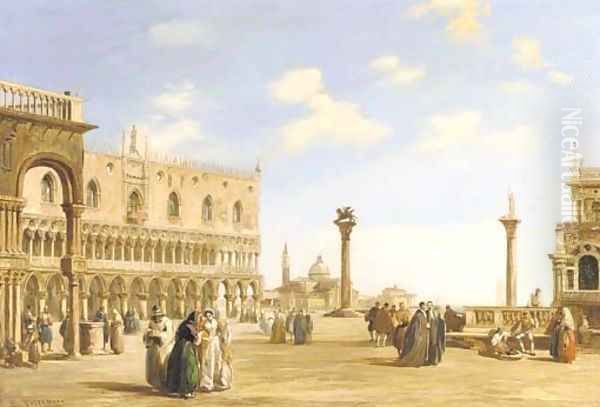
Edward Pritchett remains a somewhat enigmatic yet undeniably talented figure in the history of British art. As a dedicated painter of Venice, he followed in the footsteps of illustrious predecessors but forged his own distinct style, characterized by vibrant execution, atmospheric depth, and a remarkable sensitivity to the city's unique light. His numerous views of the Grand Canal, St. Mark's Square, and iconic landmarks like Santa Maria della Salute capture the visual splendor and lively energy of Venice during the Victorian era.
While biographical details are sparse and subject to some confusion, his artistic legacy is clear. His works, exhibited regularly at the Royal Academy and the British Institution, found favour with the public and secured his reputation during his lifetime. Today, his paintings are valued for their skillful blend of topographical representation and painterly verve, offering an appealing vision of Venice that bridges the gap between traditional view painting and the emerging concerns of Impressionism. Edward Pritchett's canvases continue to transport viewers to the sunlit canals and bustling squares of the Serenissima, securing his place as a master interpreter of the city's enduring allure.